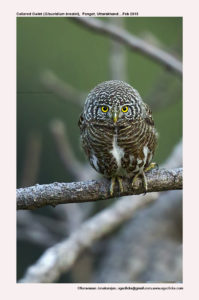
Collared Owlet Glaucidium brodiei
Etymology :
- Glaucidium : Greek for little owl derived fromglaux- owl
- Brodiei : Named after British officer Sir Benjamin Collins Brodie (1783–1862)
Vernacular Names : Cachar: Dao whit-whit
Distribution in India: Resident of Himalayas and North East India
Description: Size of 15–17 cm; wt. of male is 53 g, Wt. of female is 63 g. It is a tiny owl with rounded head, large for size of body. It has a rufous and grey-brown colour morphs. It has a crown spotted in creamy-buff, with staring “dorsal face” on nape. It has white eyebrows, white throat patch,barred dark brown and buff on back, tail and flight-feathers. The scapulars tipped white, forming interrupted lines down sides of mantle; breast sides and flanks are barred, belly sides are streaked; irides are golden-yellow; cere is greenish to bluish; bill is greenish-yellow, darkest at base, tarsi is feathered white, toes are greenish-yellow. Juvenile has vertical tear-drop marks on upper breast.
Habitat:It is found in montane and sub-montane forest, open forest edge, woodland and scrub. It is found from 700-2900 m.
Food habits: It eats birds like nestling Barbets, woodpeckers and thrushes, insects, rodents and lizard .It is diurnal; active around dusk and at night, but also hunts during all hours of day. Hunts from perch, such as fence post; swoops to catch insects in flight. It holds larger prey with foot while tearing at it with bill. It is often mobbed by passerines.
Breeding habits: They breed in Mar–Jun in Himalayas. They nest in a tree cavity above ground and displace Woodpeckers or Barbets to acquire cavity. They lay a clutch of usually 3–6 eggs. The incubation period is. 25 days. The eggs hatch asynchronously and both adults feed nestlings.